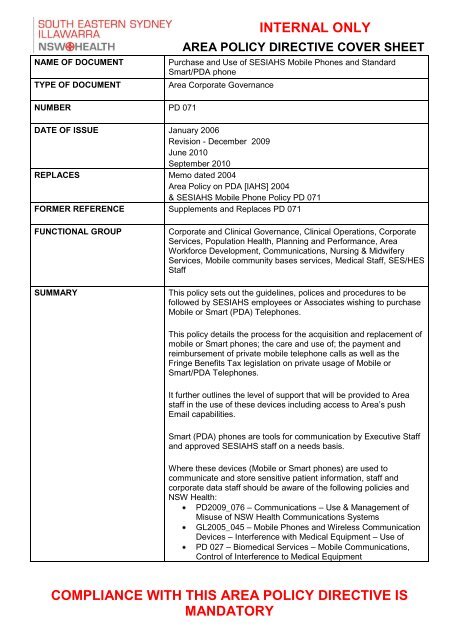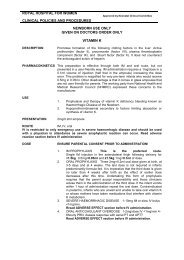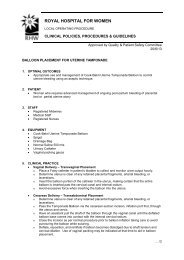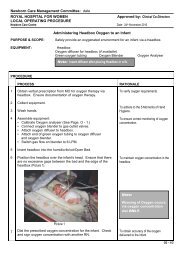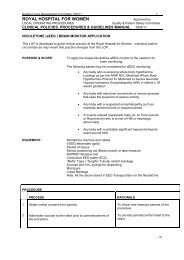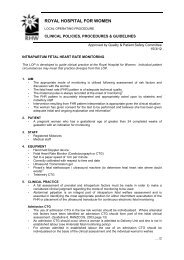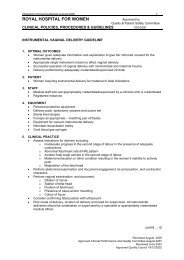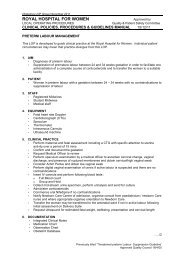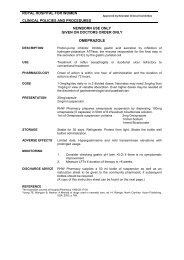INTERNAL ONLY COMPLIANCE WITH THIS AREA POLICY ...
INTERNAL ONLY COMPLIANCE WITH THIS AREA POLICY ...
INTERNAL ONLY COMPLIANCE WITH THIS AREA POLICY ...
Create successful ePaper yourself
Turn your PDF publications into a flip-book with our unique Google optimized e-Paper software.
NAME OF DOCUMENT<br />
TYPE OF DOCUMENT<br />
NUMBER<br />
DATE OF ISSUE<br />
REPLACES<br />
FORMER REFERENCE<br />
FUNCTIONAL GROUP<br />
<strong>INTERNAL</strong> <strong>ONLY</strong><br />
<strong>AREA</strong> <strong>POLICY</strong> DIRECTIVE COVER SHEET<br />
Purchase and Use of SESIAHS Mobile Phones and Standard<br />
Smart/PDA phone<br />
Area Corporate Governance<br />
PD 071<br />
January 2006<br />
Revision - December 2009<br />
June 2010<br />
September 2010<br />
Memo dated 2004<br />
Area Policy on PDA [IAHS] 2004<br />
& SESIAHS Mobile Phone Policy PD 071<br />
Supplements and Replaces PD 071<br />
Corporate and Clinical Governance, Clinical Operations, Corporate<br />
Services, Population Health, Planning and Performance, Area<br />
Workforce Development, Communications, Nursing & Midwifery<br />
Services, Mobile community bases services, Medical Staff, SES/HES<br />
Staff<br />
SUMMARY This policy sets out the guidelines, polices and procedures to be<br />
followed by SESIAHS employees or Associates wishing to purchase<br />
Mobile or Smart (PDA) Telephones.<br />
This policy details the process for the acquisition and replacement of<br />
mobile or Smart phones; the care and use of; the payment and<br />
reimbursement of private mobile telephone calls as well as the<br />
Fringe Benefits Tax legislation on private usage of Mobile or<br />
Smart/PDA Telephones.<br />
It further outlines the level of support that will be provided to Area<br />
staff in the use of these devices including access to Area’s push<br />
Email capabilities.<br />
Smart (PDA) phones are tools for communication by Executive Staff<br />
and approved SESIAHS staff on a needs basis.<br />
Where these devices (Mobile or Smart phones) are used to<br />
communicate and store sensitive patient information, staff and<br />
corporate data staff should be aware of the following policies and<br />
NSW Health:<br />
PD2009_076 – Communications – Use & Management of<br />
Misuse of NSW Health Communications Systems<br />
GL2005_045 – Mobile Phones and Wireless Communication<br />
Devices – Interference with Medical Equipment – Use of<br />
PD 027 – Biomedical Services – Mobile Communications,<br />
Control of Interference to Medical Equipment<br />
<strong>COMPLIANCE</strong> <strong>WITH</strong> <strong>THIS</strong> <strong>AREA</strong> <strong>POLICY</strong> DIRECTIVE IS<br />
MANDATORY
Purchase and Use of SESIAHS Mobile Phones<br />
and Standard Smart/PDA phone Policy<br />
<strong>INTERNAL</strong> <strong>ONLY</strong><br />
<strong>AREA</strong> <strong>POLICY</strong><br />
PD 071<br />
1. PURPOSE & SCOPE<br />
To inform all Area Health Services employees of the policy and processes relating to:<br />
the selection, approval, acquisition and replacement of mobile or smart phones/PDAs;<br />
the care and use of mobile or smart phones/PDA;<br />
the payment of accounts and reimbursement of private mobile calls, and<br />
the impact of Fringe Benefits Tax (FBT) legislation on private usage of mobile phones<br />
and or calls received on smart phones/PDAs.<br />
2. RESPONSIBILITIES<br />
Employees of South Eastern Sydney and Illawarra Area Health Service who use a mobile<br />
or smart/PDA phone, owned by the Area Health Service.<br />
Director Financial & Corporate Services<br />
Chief Information Officer<br />
Network Communications Coordinators<br />
Financial and Procurement Control Unit<br />
3. REFERENCES<br />
3.1 External References<br />
Fringe Benefits Tax (FBT) Assessment Act 1985<br />
Salaried Senior Medical Practitioners’ Award and Determination<br />
NSW Health Policy Directive PD2009_076 Communications systems<br />
Guidelines relating to interference with electronic medical equipment GL2005_045<br />
3.2 Internal References<br />
Area Policy Directive PD 061 Code of Conduct<br />
Area Biomedical Engineering Services Policy Directive PD 027<br />
Email Guidelines and Procedures.<br />
Area Policy Directive PD 059 Motor Vehicle Policy<br />
4. DEFINITIONS<br />
Area Health Service is South Eastern Sydney and Illawarra Area Health Service<br />
(SESIAHS)<br />
Associate is a person who is not an Employee, such as VMO’s, Contractors etc.<br />
Employee is a person employed by the Area Health Service as defined within this policy<br />
(including executives, SES and HES equivalent employees), and Staff Specialists<br />
REVISION 4 Ref: D06/6153 Date: September 2010 Page 1 of 9<br />
<strong>THIS</strong> <strong>AREA</strong> DOCUMENT BECOMES UNCONTROLLED WHEN PRINTED OR DOWNLOADED UNLESS REGISTERED BY<br />
LOCAL DOCUMENT CONTROL PROCEDURES<br />
<strong>INTERNAL</strong> <strong>ONLY</strong>
Purchase and Use of SESIAHS Mobile Phones<br />
and Standard Smart/PDA phone Policy<br />
<strong>INTERNAL</strong> <strong>ONLY</strong><br />
<strong>AREA</strong> <strong>POLICY</strong><br />
PD 071<br />
Fringe Benefits Tax (FBT) is a payment to an employee, but in a different form to salary<br />
or wages, which is provided in respect of employment. Benefit can include rights,<br />
privileges or services.<br />
Goods and Services Tax (GST) is the broad-based tax (current 10%) on the supply of<br />
most goods and services consumed in Australia<br />
Mobile Phone refers to telephones which provide access only to telephone messaging<br />
systems.<br />
MBRS is Telstra’s Management and Billing Reporting System<br />
Smart Phone is a term sometimes used to characterise a wireless telephone set with<br />
special computer-enabled features not previously associated with telephones. In addition<br />
to functioning as an ordinary telephone, a Smart phone’s features may include wireless email,<br />
internet, web browsing, fax intercom function, personal information management,<br />
LAN connectivity, graffiti style data entry, local data transfer between phone set and<br />
computers, remote data transfer between phone set and computers, remote control of<br />
computers and interactivity with unified messaging. Smart Phones are sometimes<br />
referred to as a PDA.<br />
5. <strong>POLICY</strong><br />
In the following paragraphs, unless otherwise stated, the same conditions will apply to<br />
both Mobile and Smart/PDA Telephones.<br />
5.1 Acquisition and Approval of Mobile/Smart Phones<br />
Mobile Phones<br />
Mobile telephones are provided only in circumstances where there is a demonstrated<br />
work need, such as a requirement to be contactable after hours, or where there is a<br />
regular requirement to work outside the usual office environment. Mobile phones can be<br />
used to connect to electronic messaging systems. They provide benefits that can<br />
significantly add value to service delivery.<br />
Mobiles phones that are consistent with the Area's standard will be the only models that<br />
may be purchased. Due to the amount of support required the number of devices that<br />
can be supplied by the Area is limited.<br />
Final approval by the Network/General Managers and Executive Directors is required for<br />
the purchase of a new or replacement mobile phone (Refer to Delegations of Authority<br />
Manual, category 14.9).<br />
REVISION 4 Ref: D06/6153 Date: September 2010 Page 2 of 9<br />
<strong>THIS</strong> <strong>AREA</strong> DOCUMENT BECOMES UNCONTROLLED WHEN PRINTED OR DOWNLOADED UNLESS REGISTERED BY<br />
LOCAL DOCUMENT CONTROL PROCEDURES<br />
<strong>INTERNAL</strong> <strong>ONLY</strong>
Purchase and Use of SESIAHS Mobile Phones<br />
and Standard Smart/PDA phone Policy<br />
<strong>INTERNAL</strong> <strong>ONLY</strong><br />
<strong>AREA</strong> <strong>POLICY</strong><br />
The process for the purchase of a new mobile phone is as follows:<br />
PD 071<br />
1. Identified need and justification for the purchase of a mobile phone.<br />
2. Funding arrangements for the initial purchase and ongoing operating costs<br />
identified.<br />
3. A Mobile Phone Purchase Details Form (Form F034) should be completed and<br />
signed by the officer requesting the Mobile phone.<br />
4. Written justification supporting the purchase needs to be attached to the form.<br />
Justification should include, but not be limited to, the purpose for which the phone<br />
is being purchased, source of purchase funds and commitment to ongoing phone<br />
call charges, cost savings and benefit to the Department. This justification is not<br />
required for replacement of like equipment.<br />
5. Approval should be obtained from the Manager and then the Network/General<br />
Manager/Executive Director.<br />
6. Authorised forms should be forwarded to the Network Communications<br />
Coordinator to arrange the purchase and Mobile phone account to be created.<br />
7. If the Mobile phone is to be allocated to a single user, a Private Use Declaration<br />
Form (Form F035) is to be completed and forwarded to Financial and Procurement<br />
Control Unit.<br />
For audit purposes, copies of forms should be kept for your records.<br />
Smart Phone<br />
Smart Phones are provided only in circumstances where there is a demonstrated work<br />
need, such as staff that are regularly away from other communication devices (i.e. away<br />
from Desktop PC) and have the need to access Emails / Calendar / Contacts 24 hours, 7<br />
days a week and the need to respond to Government / Departmental / Media requests<br />
immediately. The benefit of acquiring a Smart phone/PDA device is that it provides<br />
automatic synchronisation of emails with the Area email accounts, as well as the ability to<br />
make telephone calls. Submissions are considered on a case by case basis.<br />
Smart phones that are consistent with the Area's standard will be the only models that<br />
may be purchased. Due to the amount of support required the number of devices that<br />
can be supplied by the Area is limited. The supported Smart Phones can be found at:<br />
http://sesiweb.lan.sesahs.nsw.gov.au/ISD/Procurement/Communications_Equipment/sma<br />
rtphone.asp<br />
Non-standard Smart Phones purchased after the date of this policy will not be supported<br />
by ISD.<br />
REVISION 4 Ref: D06/6153 Date: September 2010 Page 3 of 9<br />
<strong>THIS</strong> <strong>AREA</strong> DOCUMENT BECOMES UNCONTROLLED WHEN PRINTED OR DOWNLOADED UNLESS REGISTERED BY<br />
LOCAL DOCUMENT CONTROL PROCEDURES<br />
<strong>INTERNAL</strong> <strong>ONLY</strong>
Purchase and Use of SESIAHS Mobile Phones<br />
and Standard Smart/PDA phone Policy<br />
<strong>INTERNAL</strong> <strong>ONLY</strong><br />
<strong>AREA</strong> <strong>POLICY</strong><br />
PD 071<br />
Final approval by the Director Financial and Corporate Services (for new Smart Phones)<br />
or Chief Information Officer (for replacement Smart Phones) will be obtained by Northern<br />
Network Communications Coordinator. (Refer to Delegations of Authority Manual,<br />
category 14.9).<br />
The process for the purchase of a new Smart Phone is as follows:<br />
1. Identified need and justification for the purchase of a Smart phone.<br />
2. Funding arrangements for the initial purchase and ongoing operating costs<br />
identified.<br />
3. A Smart Phone Purchase Details Form (Form F175) should be completed and<br />
signed by the officer requesting the Smart phone.<br />
4. Written justification supporting the purchase needs to be attached to the form.<br />
Justification should include, but not be limited to, the purpose for the which the<br />
device is being purchased, source of purchase funds and commitment to ongoing<br />
phone call / downloading charges, the benefits of using this technology including<br />
cost savings and the improvement to clinical or corporate services, where<br />
appropriate. This justification is not required for replacement of like equipment.<br />
5. Approval should be obtained from the Manager and then the Network/General<br />
Manager/Executive Director.<br />
6. Approved form and supporting justification are then to be forwarded to Northern<br />
Network Communications Coordinator (NNCC), Prince of Wales Hospital. NNCC<br />
will then arrange for final approval from the Director Financial and Corporate<br />
Services (for new purchases only) or Chief Information Officer (for replacement<br />
purchases only).<br />
7. Once approved, NNCC will arrange for the purchase of the Smart Phone, data<br />
account to be setup, arrange handover, configuration and setup of the Email<br />
system on the Smart Phone.<br />
8. A Private Use Declaration Form (Form F035) is to be completed and forwarded to<br />
Financial and Procurement Control Unit.<br />
For audit purposes, copies of both forms should be kept for your records.<br />
5.2 Pricing Structure for Mobile/Smart Phones<br />
NSW Health has a contract in place with Telstra to supply services for Mobile/Smart<br />
Phones. Under this contract, calls from and to mobile phones are time charged on a<br />
tiered rate structure, based on average annual usage. This usage tiered rate is reviewed<br />
annually and adjusted accordingly. For Smart phones, new connections are placed on a<br />
2 year contract; however, an additional charge per month is incurred for telephone calls<br />
and the cost of storage and synchronisation of emails.<br />
REVISION 4 Ref: D06/6153 Date: September 2010 Page 4 of 9<br />
<strong>THIS</strong> <strong>AREA</strong> DOCUMENT BECOMES UNCONTROLLED WHEN PRINTED OR DOWNLOADED UNLESS REGISTERED BY<br />
LOCAL DOCUMENT CONTROL PROCEDURES<br />
<strong>INTERNAL</strong> <strong>ONLY</strong>
Purchase and Use of SESIAHS Mobile Phones<br />
and Standard Smart/PDA phone Policy<br />
<strong>INTERNAL</strong> <strong>ONLY</strong><br />
<strong>AREA</strong> <strong>POLICY</strong><br />
PD 071<br />
The monthly capped tier charging for mobile phones include services such as national<br />
and mobile telephone calls, national SMS, MessageBank diversion, MessageBank<br />
retrieval and 1300 calls. For Smart Phones the capped tier charge includes the same as<br />
Mobile Phones, as well as Good Mail services, unlimited email and downloads.<br />
Additional charges not included on Mobile phone tiered plans include International calls,<br />
International SMS, Premium SMS, video streaming, MMS, diversion to other devices,<br />
1800/Directory Assistance calls and push to talk. For Smart phones the exclusions are<br />
the same as Mobile phones, as well as internet browsing.<br />
Where SESIAHS will incur costs, users of Mobile/Smart phones are required to keep calls<br />
as short as possible.<br />
Further details of tiered rates can be obtained from the Network Communications<br />
Coordinator.<br />
5.3 Private Use of Mobile/Smart Phones<br />
The Area Health Service requires that personal use of Mobile/Smart phones for services<br />
that are unrelated to Area/Hospital/Service business (ie. private phone calls etc) must be<br />
reimbursed to the Area/Hospital/Service.<br />
Private usage contributions form part of the terms and conditions under which private use<br />
of Mobile/Smart phones is permitted. The guidelines for personal use are contained in the<br />
NSW Health Policy directive PD2009_076 (Communication Systems) and apply equally to<br />
all types of telephones, including Mobile and Smart telephones. Staff members are<br />
responsible for notifying the Financial and Procurement Control Unit if they no longer<br />
require private usage on their Mobile/Smart phone or they no longer have the phone.<br />
Such notification must be certified by Site Managers. It is possible for an employee to<br />
make a notification to the Financial and Procurement Control Unit and cancel<br />
contributions without relinquishing use of the phone. A private phone call made by an<br />
employee to a family member, notifying that they are delayed because of employment<br />
related duties, is exempt from reimbursement.<br />
Private usage contributions for staff (including Staff Specialists) are processed through<br />
the payroll as fortnightly payroll deductions. For SES/HES staff and VMO’s this will be on<br />
a monthly basis. The minimal contribution for private usage is a minimum of $2.50 per<br />
fortnight. On commencement, staff will be placed on the lowest plan and are required to<br />
nominate an amount for private usage by completing and submitting Form F035 to the<br />
Financial and Procurement Control Unit, MRD Building, Sutherland Hospital. Once<br />
verified, the form will be forwarded to Payroll Services to commence the payroll<br />
deductions. The nominated amount will continue to be deducted, unless notified<br />
otherwise in writing.<br />
REVISION 4 Ref: D06/6153 Date: September 2010 Page 5 of 9<br />
<strong>THIS</strong> <strong>AREA</strong> DOCUMENT BECOMES UNCONTROLLED WHEN PRINTED OR DOWNLOADED UNLESS REGISTERED BY<br />
LOCAL DOCUMENT CONTROL PROCEDURES<br />
<strong>INTERNAL</strong> <strong>ONLY</strong>
Purchase and Use of SESIAHS Mobile Phones<br />
and Standard Smart/PDA phone Policy<br />
The private use conversion table is as follows:<br />
<strong>INTERNAL</strong> <strong>ONLY</strong><br />
<strong>AREA</strong> <strong>POLICY</strong><br />
Minutes of Private<br />
Usage per Month<br />
Cost per Fortnight Cost per Month<br />
0 – 20 mins $2.50 $5.00<br />
21 – 40 mins $4.00 $8.00<br />
41 – 60 mins $5.50 $11.00<br />
61 – 80 mins $7.00 $14.00<br />
81 – 100 mins $8.50 $17.00<br />
101 – 120 mins $10.00 $20.00<br />
121 – 180 mins $12.50 $25.00<br />
181 – 240 mins $15.00 $30.00<br />
241 – 300 mins $17.50 $35.00<br />
301 – 360 mins $20.00 $40.00<br />
The above table provides for:<br />
PD 071<br />
An option for no private usage that does include the ability for minimal calls to be<br />
made to notify partners that they are running late etc.<br />
Pool phones will not be included in this process as no private usage will apply to these<br />
numbers.<br />
Staff can nominate to receive an emailed copy of their monthly phone account from<br />
Telstra at a cost of $2.20 per annum. This option is offered on the Private Use<br />
Declaration Form - Form F035.<br />
Random audits to ensure compliance will be conducted by the Financial and<br />
Procurement Control Unit.<br />
Staff members are responsible for notifying the Financial and Procurement Control<br />
Unit, in writing, if they no longer require private usage or they no longer have the<br />
Smart/Mobile phone.<br />
Financial and Procurement Control Unit will keep a database of the staff member’s<br />
name, Mobile and Smart phone numbers, rate plan and nominated deduction amount.<br />
Forms are to be submitted to the Financial and Procurement Control Unit for<br />
certification and on-forwarding to Payroll Services and the Network Communications<br />
Coordinator.<br />
Additional services of a private nature (eg: 1800 calls, International, video streaming<br />
etc) will be charged as incurred from Telstra, and subject to further payroll deductions.<br />
Please refer to Section 5.2 for the inclusions and exclusions in your monthly account.<br />
Further details can also be obtained from the Network Communications Coordinator.<br />
Payroll Deductions are not eligible for Salary Packaging.<br />
Please note that all staff are responsible for ensuring their election is consistent with<br />
private use and will be required to make good on audit if a false declaration is detected.<br />
REVISION 4 Ref: D06/6153 Date: September 2010 Page 6 of 9<br />
<strong>THIS</strong> <strong>AREA</strong> DOCUMENT BECOMES UNCONTROLLED WHEN PRINTED OR DOWNLOADED UNLESS REGISTERED BY<br />
LOCAL DOCUMENT CONTROL PROCEDURES<br />
<strong>INTERNAL</strong> <strong>ONLY</strong>
Purchase and Use of SESIAHS Mobile Phones<br />
and Standard Smart/PDA phone Policy<br />
5.4 Care and Use of Mobile/Smart Phones<br />
<strong>INTERNAL</strong> <strong>ONLY</strong><br />
<strong>AREA</strong> <strong>POLICY</strong><br />
PD 071<br />
Staff who are users or custodians of Mobile/Smart phones should understand that calls<br />
on both Mobile and Smart phones can be intercepted, and that extra precautions must be<br />
taken to secure devices (such as activating in-built security features), as they are easily<br />
stolen.<br />
Employees who are issued with Mobile/Smart phone by the Area Health Service are<br />
responsible for their appropriate care and security. Any damage, loss or theft of a Mobile/<br />
Smart phone must be reported immediately to the employee’s Supervisor/Manager, as<br />
well as to the relevant Network Communications Coordinator. Responsibility for meeting<br />
the cost of repair or replacement of any Mobile/Smart phone may be directed to the<br />
relevant employee, if it is considered that the damage/loss was incurred through careless<br />
or inappropriate action.<br />
All employees should refrain from using Mobile/Smart phones when access to a standard<br />
hospital telephone is readily available. Further, employees should not forward their<br />
standard hospital telephones to their Mobile/Smart phone as this is extremely costly to the<br />
Area Health Service in terms of call costs. Alternatively, a voicemail message on the<br />
standard hospital telephone should include the employee’s Mobile/Smart phone number.<br />
5.4.1 Use of Mobile/Smart Phones in Motor Vehicles<br />
The use of a hand held Mobile/Smart phones while driving is an offence. Staff must pull<br />
off the road and park before using a hand held device. Alternatively, the use of<br />
MessageBank service should be utilised. The Area Health Service will not be responsible<br />
for any fines incurred by staff improperly using Mobile/Smart phones. Involvement in an<br />
accident while using a hand held device could also negate any insurance claim.<br />
Hands free/Bluetooth kits are not always provided as a standard accessory in Area Health<br />
Service vehicles. Hands free/Bluetooth kits can be purchased if an operational need can<br />
be clearly demonstrated. Further information can be obtained from the Network<br />
Communications Coordinator.<br />
5.4.2 Use of Mobile/Smart Phones around Electronic Medical Equipment<br />
Whilst the risk of interference with electronic medical equipment when using Mobile/Smart<br />
phones may appear small, it is considered important that the safest possible environment<br />
be provided for patients.<br />
REVISION 4 Ref: D06/6153 Date: September 2010 Page 7 of 9<br />
<strong>THIS</strong> <strong>AREA</strong> DOCUMENT BECOMES UNCONTROLLED WHEN PRINTED OR DOWNLOADED UNLESS REGISTERED BY<br />
LOCAL DOCUMENT CONTROL PROCEDURES<br />
<strong>INTERNAL</strong> <strong>ONLY</strong>
Purchase and Use of SESIAHS Mobile Phones<br />
and Standard Smart/PDA phone Policy<br />
<strong>INTERNAL</strong> <strong>ONLY</strong><br />
<strong>AREA</strong> <strong>POLICY</strong><br />
PD 071<br />
All users of Mobile/Smart phones should familiarise themselves with the following Policy<br />
Directive’s in relation to the Interference with Electronic Medical Equipment:<br />
Area Policy PD 027 “Mobile Communications – Control of Interference to Medical<br />
Equipment”<br />
Department of Health Directive – “Use of Mobile Telephones and Wireless<br />
Communication Devices – Interference with Electronic Medical Equipment” –<br />
GL2005_045 – formerly Circular 2003/65)<br />
5.5 Fringe Benefits Tax (FBT)<br />
Fringe benefits may be regarded as any payment to an employee, but in a different form<br />
to salary and wages. A benefit, which is provided in respect of employment, includes any<br />
right, privilege, service, or facility.<br />
A Fringe Benefit would generally arise when the employer pays all or part of the cost<br />
associated with an employee benefit. However, Fringe Benefits Tax Legislation (S.58X)<br />
specifically exempts mobile phone and mobile phone usage from Fringe Benefits Tax,<br />
providing the mobile phone is primarily (greater than 51%) for use in an employee’s<br />
employment.<br />
Consequently, private phone calls made from a mobile phone are exempt from FBT if the<br />
business usage of the mobile phone is greater than 51%. Despite the FBT exemption,<br />
the Area Health Service does not pay for private phone calls component on the mobile<br />
phone account.<br />
5.6 Senior Medical Practitioners<br />
Where Senior Medical Practitioners’ Mobile/Smart phones are used predominantly for<br />
business purposes and related expenses are paid from Rights of Private Practice No 2<br />
Accounts, no further contribution for personal calls is required.<br />
5.7 Terminating Employees<br />
Terminating employees must ensure that Area Health Service Mobile/Smart phones are<br />
returned to their respective supervisor/manager, prior to their last day of employment.<br />
Additionally, written notice should be given to the Financial and Procurement Control Unit<br />
to cease payroll deductions.<br />
5.8 Policy Compliance<br />
The Area Health Service has put in place controls to monitor use of Mobile/Smart phones<br />
provided to staff and to detect any failure to comply with this policy.<br />
REVISION 4 Ref: D06/6153 Date: September 2010 Page 8 of 9<br />
<strong>THIS</strong> <strong>AREA</strong> DOCUMENT BECOMES UNCONTROLLED WHEN PRINTED OR DOWNLOADED UNLESS REGISTERED BY<br />
LOCAL DOCUMENT CONTROL PROCEDURES<br />
<strong>INTERNAL</strong> <strong>ONLY</strong>
Purchase and Use of SESIAHS Mobile Phones<br />
and Standard Smart/PDA phone Policy<br />
<strong>INTERNAL</strong> <strong>ONLY</strong><br />
<strong>AREA</strong> <strong>POLICY</strong><br />
PD 071<br />
Random audits of Mobile/Smart phone accounts will be conducted to ensure employees<br />
are complying with this Policy. Other controls will include reviewing appropriate<br />
approvals, usage disclosure and monitoring for improper use.<br />
Using MBRS, the Financial and Procurement Control Unit will issue exception reports to<br />
those users whose usage pattern reflects monthly usage in excess of the allowable called<br />
minutes within the allocated plan. Where usage exceeds the allocation in three<br />
consecutive months, private contributions will be adjusted in line with the increase in<br />
accordance with the pricing structure as set from time to time under the NSW Health<br />
contract.<br />
In the event of continued disregard to this policy, (including Section 5.3 relating to the<br />
recovery of the cost of private mobile phone calls) consideration will be given to:<br />
Removing the Mobile/Smart phone from the employee, and<br />
Suspending the service to the Mobile/Smart phone.<br />
6. DOCUMENTATION<br />
Mobile Phone Purchase Details – Area Form F034<br />
Smart Phone Purchase Details – Area Form F175<br />
Private Use Declaration Form – Area Form F035 (Amend for discontinuance of Private<br />
use)<br />
7. REVISION & APPROVAL HISTORY<br />
Date Revision No. Author and Approval<br />
Dec 2003 0 Former SESAHS Policy<br />
January 2006 1 Alison Briggs, Contracts Coordinator in consultation with Area<br />
Communications Managers. Approved for release by the<br />
Executive Management Committee 31 January 2006<br />
March 2010 2 Amended to include new and updated technology.<br />
Approved by the Area Finance and Performance Committee –<br />
23 February 2010<br />
June 2010 3 Slight amendments – approved by Director Finance and<br />
Corporate Services<br />
September 2010 4 Amendments to include new and updated information –<br />
Approved by Finance and Performance Committee 28/9/10<br />
REVISION 4 Ref: D06/6153 Date: September 2010 Page 9 of 9<br />
<strong>THIS</strong> <strong>AREA</strong> DOCUMENT BECOMES UNCONTROLLED WHEN PRINTED OR DOWNLOADED UNLESS REGISTERED BY<br />
LOCAL DOCUMENT CONTROL PROCEDURES<br />
<strong>INTERNAL</strong> <strong>ONLY</strong>


